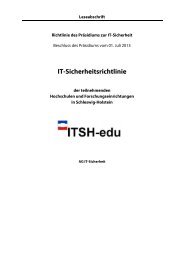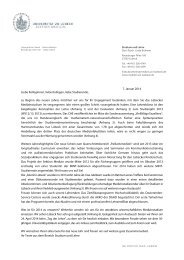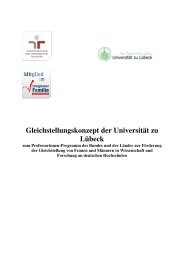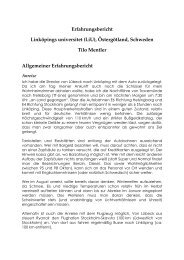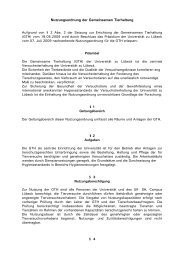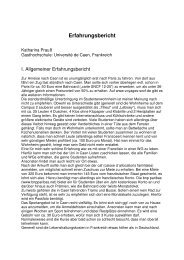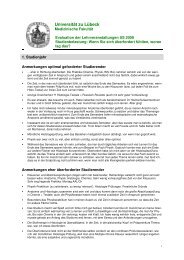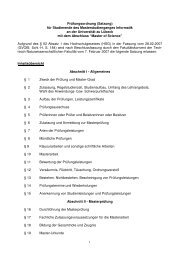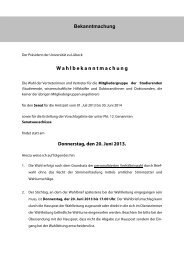(focus)uni lübeck - Universität zu Lübeck
(focus)uni lübeck - Universität zu Lübeck
(focus)uni lübeck - Universität zu Lübeck
Erfolgreiche ePaper selbst erstellen
Machen Sie aus Ihren PDF Publikationen ein blätterbares Flipbook mit unserer einzigartigen Google optimierten e-Paper Software.
| Forschung aktuell<br />
Als neueres Einsatzgebiet kann die zerebrale Oximetrie als<br />
kontinuierliches, nicht-invasives Messverfahren auch <strong>zu</strong>r hämodynamischen<br />
Therapiesteuerung und Optimierung während<br />
des Eingriffs herangezogen werden, sofern die verschiedenen<br />
Determinanten der zerebralen Perfusion wie CO 2 und<br />
zerebraler Metabolismus klinisch mit berücksichtigt werden.<br />
Die dargestellten positiven Befunde <strong>zu</strong>m Zusammenhang<br />
von gemischtvenöser und zerebraler Sättigung müssen allerdings<br />
durch größere Stichproben weiter untermauert werden.<br />
Ob die zerebrale Oxygenierung als Surrogat-Parameter<br />
der globalen Hämodynamik auch in anderen operativen oder<br />
nicht-operativen Fachdisziplinen einen signifikanten Stellenwert<br />
hat, muss in weiteren Untersuchungen geklärt werden.<br />
Weiter ist offen, ob eine mittelfristig medikamentös verbesserte<br />
Hämodynamik die zerebrale Sättigung verbessert und<br />
ob diese damit auch <strong>zu</strong> einem verbesserten Outcome führt.<br />
Die Verbindung der zerebralen Oximetrie <strong>zu</strong>r Funktion<br />
(=kognitive Leistung) auf der einen Seite und der Struktur<br />
(=zerebrales Gefäßbett) auf der anderen Seite macht sie auch<br />
in wissenschaftlicher Hinsicht <strong>zu</strong> einem wertvollen Werkzeug<br />
im Bereich kognitiver Störungen nicht nur im kardioanästhesiologischen<br />
Bereich. Zu denken wäre hier z.B. an kognitive<br />
Störungen in der Sepsis 34 , einem Krankheitsbild, bei dem das<br />
Zusammenspiel von Inflammation, zerebraler Perfusion und<br />
kognitiver Beeinträchtigung weitgehend ungeklärt ist. Weiter<br />
könnte die zerebralen Oximetrie <strong>zu</strong>r Abschät<strong>zu</strong>ng von<br />
Beeinträchtigungen der zerebralen Autoregulation 34,35 , <strong>zu</strong>m<br />
Beispiel während der extrakorporalen Zirkulation oder auch<br />
bei Hirnödem durch schwere Traumata, eingesetzt werden 36 ,<br />
auch hier ist die Datenlage bislang noch sehr gering.<br />
Die klinischen Schlussfolgerungen aus den durchgeführten<br />
Untersuchungen sind <strong>zu</strong>m einen, dass eine intraoperative<br />
zerebrale Sauerstoffsättigung (S c O 2 ) unter 50 Prozent als<br />
potenziell bedrohlich ein<strong>zu</strong>stufen ist und behandelt werden<br />
sollte. Zum anderen muss eine niedrige präoperative zerebrale<br />
Sauerstoffsättigung als Risikofaktor betrachtet werden,<br />
der möglicherweise die Wahl des perioperativen Monitorings<br />
und die Therapie mit beeinflusst.<br />
Man kann <strong>zu</strong>sammenfassen, dass die regionale zerebrale<br />
Sauerstoffsättigung ein unverzichtbarer Bestandteil des perioperativen<br />
Monitorings herzchirurgischer Patienten <strong>zu</strong>r Optimierung<br />
des neurologischen und allgemeinen Ergebnisses<br />
herzchirurgischer Eingriffe ist.<br />
Literatur<br />
1. Ferguson TB, Jr., Hammill BG, Peterson ED, DeLong ER, Grover FL. A decade of<br />
change--risk profiles and outcomes for isolated coronary artery bypass grafting<br />
procedures, 1990-1999: a report from the STS National Database Committee<br />
and the Duke Clinical Research Institute. Society of Thoracic Surgeons. The<br />
Annals of Thoracic Surgery. Feb 2002;73(2):480-489; discussion 489-490.<br />
2. Weintraub WS, Jones EL, Craver J, Guyton R, Cohen C. Determinants of prolonged<br />
length of hospital stay after coronary bypass surgery. Circulation. Aug<br />
1989;80(2):276-284.<br />
3. Newman MF, Grocott HP, Mathew JP, et al. Report of the substudy assessing<br />
the impact of neurocognitive function on quality of life 5 years after cardiac<br />
29. JAHRGANG | HEFT 2 | OKTOBER 2012 |<br />
surgery. Stroke. Dec 1 2001;32(12):2874-2881.<br />
4. Deiner S, Silverstein JH. Postoperative delirium and cognitive dysfunction. Br J<br />
Anaesth. Dec 2009;103 Suppl 1:i41-46.<br />
5. Newman MF, Mathew JP, Grocott HP, et al. Central nervous system injury associated<br />
with cardiac surgery. Lancet. Aug 19 2006;368(9536):694-703.<br />
6. Ngaage DL, Cowen ME, Griffin S, Guvendik L, Cale AR. Early neurological complications<br />
after coronary artery bypass grafting and valve surgery in octogenarians.<br />
European journal of cardio-thoracic surgery : official journal of the European<br />
Association for Cardio-thoracic Surgery. Apr 2008;33(4):653-659.<br />
7. Koster S, Hensens AG, Schuurmans MJ, van der Palen J. Risk factors of delirium<br />
after cardiac surgery: A systematic review. European Journal of Cardiovascular<br />
Nursing.In Press, Corrected Proof.<br />
8. Chang Y-L, Tsai Y-F, Lin P-J, Chen M-C, Liu C-Y. Prevalence and Risk Factors for<br />
Postoperative Delirium in a Cardiovascular Intensive Care Unit. Am J Crit Care.<br />
November 1, 2008 2008;17(6):567-575.<br />
9. Newman MF, Croughwell ND, Blumenthal JA, et al. Effect of aging on cerebral<br />
autoregulation during cardiopulmonary bypass. Association with postoperative<br />
cognitive dysfunction. Circulation. Nov 1994;90(5 Pt 2):II243-249.<br />
10. Hogue CW, Jr., Palin CA, Arrowsmith JE. Cardiopulmonary bypass management<br />
and neurologic outcomes: an evidence-based appraisal of current<br />
practices. Anesth Analg. Jul 2006;103(1):21-37.<br />
11. Roach GW, Kanchuger M, Mangano CM, et al. Adverse cerebral outcomes after<br />
coronary bypass surgery. Multicenter Study of Perioperative Ischemia Research<br />
Group and the Ischemia Research and Education Foundation Investigators.<br />
The New England journal of medicine. Dec 19 1996;335(25):1857-1863.<br />
12. Guarracino F. Cerebral monitoring during cardiovascular surgery. Curr Opin<br />
Anaesthesiol. Feb 2008;21(1):50-54.<br />
13. Hoffman GM. Neurologic monitoring on cardiopulmonary bypass: what are<br />
we obligated to do? Ann Thorac Surg. Jun 2006;81(6):S2373-2380.<br />
14. Saidi N, Murkin JM. Applied Neuromonitoring in Cardiac Surgery: Patient Specific<br />
Management. Seminars in Cardiothoracic and Vascular Anesthesia. March<br />
1, 2005 2005;9(1):17-23.<br />
15. Zanatta P, Benvenuti SM, Bosco E, Baldanzi F, Palomba D, Valfre C. Multimodal<br />
Brain Monitoring Reduces Major Neurologic Complications in Cardiac Surgery.<br />
Journal of Cardiothoracic and Vascular Anesthesia. Jul 27 2011.<br />
16. Edmonds HL, Jr. Multi-modality neurophysiologic monitoring for cardiac surgery.<br />
Heart Surg Forum. 2002;5(3):225-228.<br />
17. Casati A, Fanelli G, Pietropaoli P, et al. Continuous monitoring of cerebral oxygen<br />
saturation in elderly patients undergoing major abdominal surgery minimizes<br />
brain exposure to potential hypoxia. Anesth Analg. Sep 2005;101(3):740-<br />
747, table of contents.<br />
18. Yao FS, Tseng CC, Ho CY, Levin SK, Illner P. Cerebral oxygen desaturation is associated<br />
with early postoperative neuropsychological dysfunction in patients<br />
undergoing cardiac surgery. J Cardiothorac Vasc Anesth. Oct 2004;18(5):552-<br />
558.<br />
19. Kim MB, Ward DS, Cartwright CR, Kolano J, Chlebowski S, Henson LC. Estimation<br />
of jugular venous O2 saturation from cerebral oximetry or arterial O2 saturation<br />
during isocapnic hypoxia. J Clin Monit Comput. 2000;16(3):191-199.<br />
20. Macmillan CS, Andrews PJ. Cerebrovenous oxygen saturation monitoring:<br />
practical considerations and clinical relevance. Intensive Care Medicine. Aug<br />
2000;26(8):1028-1036.<br />
21. Edmonds HL, Jr., Ganzel BL, Austin EH, 3rd. Cerebral oximetry for cardiac and<br />
vascular surgery. Semin Cardiothorac Vasc Anesth. Jun 2004;8(2):147-166.<br />
22. Grocott HP. Avoid hypotension and hypoxia: an old anesthetic adage with<br />
renewed relevance from cerebral oximetry monitoring. Canadian journal of<br />
anaesthesia = Journal canadien d'anesthesie. Aug 2011;58(8):697-702.<br />
23. Joshi B, Ono M, Brown C, et al. Predicting the Limits of Cerebral Autoregulation<br />
During Cardiopulmonary Bypass. Anesthesia and analgesia. Nov 21 2011.<br />
24. Kontos HA. Regulation of the cerebral circulation. Annu Rev Physiol.<br />
1981;43:397-407.<br />
25. Akca O, Liem E, Suleman MI, Doufas AG, Galandiuk S, Sessler DI. Effect of intra-operative<br />
end-tidal carbon dioxide partial pressure on tissue oxygenation.<br />
Anaesthesia. Jun 2003;58(6):536-542.<br />
26. Yoshitani K, Kawaguchi M, Miura N, et al. Effects of hemoglobin concentration,<br />
skull thickness, and the area of the cerebrospinal fluid layer on near-infrared<br />
spectroscopy measurements. Anesthesiology. 2007;106:458 - 462.<br />
27. Heringlake M, Garbers C, Kabler JH, et al. Preoperative cerebral oxygen saturati-<br />
(<strong>focus</strong>) <strong>uni</strong> <strong>lübeck</strong><br />
11 |




